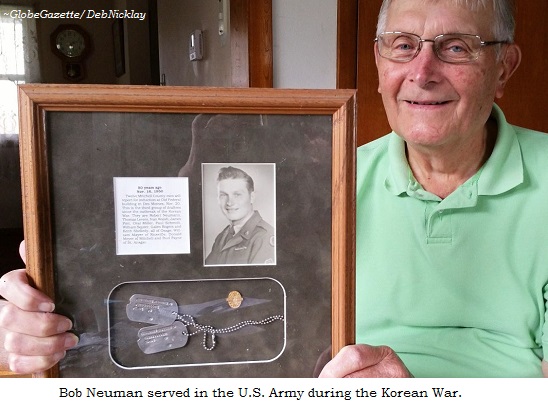


Cerro Gordo County Iowa
Part of the IAGenWeb Project
|
The Globe-Gazette
by Deb Nicklay for The Press-News

“Then I walked the last three-quarters of a mile,” he said, smiling at the memory.
That was a far cry from the reception he received when he and fellow veterans who fought in Korea, Vietnam and World War II came home from the Sullivan-Hartogh-Davis Post 730 Honor Flight to Washington D.C., on Sept. 22.
“It was something,” he said. “There must have been 100 people there to greet us” at the Waterloo Regional Airport.
“You almost bawled like a baby,” said Walters, 92, of Osage. “We never had that kind of thank you before.”
While in the nation’s capital, the group visited several memorials – World War II, Korea and Vietnam – as well as the Tomb of the Unknown Soldier. While the World War II Honor Flights are not being conducted specifically for that group any longer, they are the priority passengers on the new honor flights that are focused on Korean and Vietnam veterans.
It was the first time Walters had seen the National World War II Memorial. “You see that wall with the stars – 100 men for every star – it shakes you up,” he said.
Walters served in the U.S. Navy from 1943-1946, during World War II. He was stationed at an airfield near Pearl Harbor where he served as an airplane mechanic with special training in carburetors. He was eventually promoted to the rank of Petty Officer Second Class.
He said he was fortunate not to have experienced fighting, but found the duty of maintaining aircraft – called serving on the flight line – dangerous, nonetheless.
“We had planes taking off and landing every few minutes,” he said. “We had a few die when they were caught by wings.”
Prior to his service, he worked on building B-24s – the heavy bomber, also known as “The Liberator” -- at the Willow Run manufacturing plant in Detroit. The B-24 was the most produced aircraft of World War II.
“We built a B-24 every hour,” he said proudly. His late wife, Genevieve, was a military wife who also did her part for the war effort – she was a riveter working for Douglas Consolidated Aircraft.
The Korean War Veterans Memorial sparked lots of memories for Neumann, 88, a retired farmer who lives near St. Ansgar.
The visit to the memorial “takes you right back to that particular time,” he said.
Neumann served in the U.S. Army from 1950 to 1952. He spent just under a year in Korea. He ended his service as a staff sergeant.
He downplayed any danger during his time there, although he admitted that he saw the enemy more than once as a member of Company I, Fifth Infantry Regimental Combat Team.
“We spent most of our time patrolling,” he said. Overall, he added, his time in Korea was relatively safe – if not cold. More histories, in recent years, recount fighting a war in the extreme cold.
“You carried everything with you,” he recalled. “That first winter was a lot like it is here. I can remember trying to heat food with Sterno – you’d burn the top of the food and the middle would still be frozen.”
He laughed. “But that was about as bad as it got, for me. I was lucky,” he said.
He said that seeing the memorial honoring Korean vets “was impressive.” As others have mentioned, the memorial has impact when you see the statues of soldiers, as if they are walking on patrol.
He said he would like to know what it would be like to see those statues “under a full moon, in the middle of winter, covered in snow.
“Then it would seem real,” Neumann.
Photograph courtesy of Globe-Gazette
|
© Copyright 1996-
Cerro Gordo Co. IAGenWeb Project
All rights Reserved.